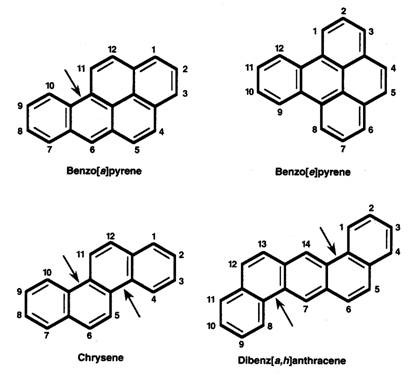Aromatic hydrocarbons – carcinogenicity and toxicity
Most polynuclear hydrocarbons are carcinogenic in nature. Polynuclear hydrocarbons contain two or more benzene rings fused together. These are also called polycyclic aromatic compounds. For example, naphthalene contains two benzene rings fused together. Other common examples are anthracene, phenanthracene, etc. the major source of these polynuclear hydrocarbons is coal tar. The isomeric monosubstituted naphthalenes are differentiated into α and β –naphthalenes. Naphthalene and other polynuclear aromatic hydrocarbons show many of the chemical properties similar to benzene. The volatile arenes are highly inflammable and burn with a yellow sooty flame. Many of these polynuclear aromatic hydrocarbons are toxic and some are carcinogenic let us discuss: It has been observed that the people who work under prolonged exposure to coal tar tends to suffer from skin cancer. A group of British chemists has studied that high boiling fluorescent fraction of coal tar produces cancer. The major component of this fraction was found to be 1,2-benzanthracene.
Later researches have shown that many other polynuclear hydrocarbons such as 3-methylcholanthracene, 1,2-benzpyrene, 9,10-dimethyl-1,2-benzanthracene, etc. are carcinogenic in nature.

It may be noted that there is no general rule by which one can predict the carcinogenic activity of hydrocarbons or their derivatives. However, the number and position of some groups such as etc. have been found to influence the carcinogenic activity of polynuclear hydrocarbons.
Such polynuclear hydrocarbons are formed by incomplete combustion of organic materials such as coal, petroleum, tobacco, etc. when these polynuclear hydrocarbons enter into the human body, they undergo various biochemical reactions and finally damage DNA and ultimately leads to cancer. Human activities such as wildfires, volcanic eruption also cause the release of polycyclic aromatic hydrocarbons. Being ubiquitous in the environment, PAHs are thought to introduce cancer tumors, primarily in the lungs, bladder and in the skin.
The international agency has classified some of these compounds as probable human carcinogens. PAHs are themselves are relatively non-reactive chemicals towards biological macromolecules under physiological conditions. Rather they require metabolic activation in order to exert genotoxicity, including mutagenicity and tumorigenicity. Upon entering the body, the cellular defense system attempts to remove these foreign substances by metabolism. PAH metabolism in a mammalian system is principally in the liver and is catalyzed mainly by the cytochrome P450 enzymes, although other metabolizing enzymes are also involved. Upon metabolism they become more water-soluble and polar to be excreted out of the body, thus completing the removal of the biological detoxification process. However, metabolism of polycyclic aromatic hydrocarbons also produces reactive intermediates which are capable of forming covalent adducts with nucleic acids, leading to genotoxicity.
It is also found that the number and positions of certain groups such as methyl, hydroxide, cyanide, and methoxy in these compounds give rise to the carcinogenic tendencies.
The elimination of carcinogenic substance from the environment can be achieved by these following steps:
- By recycling the products of the combustion of coal and petroleum products.
- By controlling the use of tobacco or by using filters to reduce the inhalation of the incomplete combustion of tobacco.